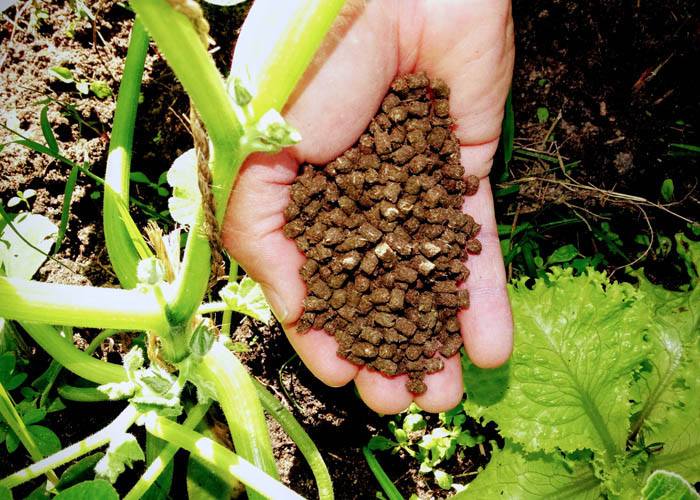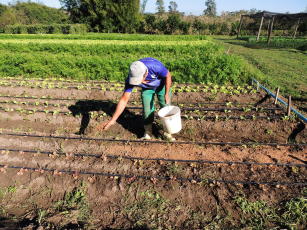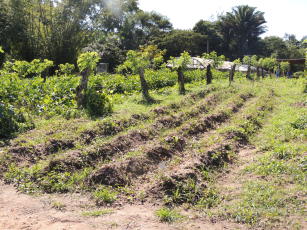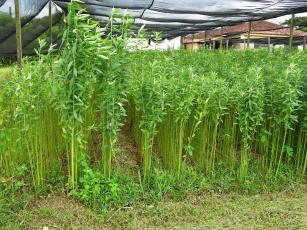Produced from the aerial biomass (part of the plant that is above ground) of leguminous species, "“N-verde”" is a nitrogen (N)-rich organic plant fertilizer that is easy to apply. “It has the essential nutrients for plants: phosphorus, potassium, calcium, magnesium, sulphur; and micronutrients, such as boron, iron, manganese, molybdenum and zinc”, explains the researcher Ednaldo Araújo, from Embrapa Agrobiology. Compared with other organic materials, “N-verde”'s nitrogen concentration is high: about 4%. Therefore, it is indicated as a source of nitrogen fertilization. Scientific studies have shown that the fertilizer developed by Embrapa Agrobiology's researchers reduces losses that occur at the time it is applied in the farm. While for commercial products losses from volatilization (when it turns into gas) reaches 50%, for “N-verde” it is a maximum of 15%, resulting in savings for the farmer. Considering that powdered fertilizers have limitations regarding field applications, as their use is not suitable in fertilizer distribution machines and favor nitrogen losses due to ammonia volatilization; the researchers developed a product in the form of granules or pellets. “The idea is to provide farmers with a fertilizer that is standardized with regard to nutrient content and particle size, and has high density and low volume, which facilitates application in the farm”, Araújo adds. At first, the product was developed to be applied on leafy vegetables, where field tests pointed to a product with excellent results. But the response was also good in maize and bean crops. The expectation is that when the industry makes it available, the product should also be well-accepted for application in ornamental plants as a nitrogen source. Production process According to the researchers, producing “N-verde” takes a nitrogen fixing legume with high capacity to generate organic matter at a low production cost. “We resorted to two biological processes that are abundant in nature, photosynthesis and biological nitrogen fixation, which the accumulation of carbon and nitrogen from plant biomass”, details José Guilherme, a researcher from Embrapa Agrobiology. Most nitrogen fixing leguminous plants have good nutrient concentration and can be used to produce “N-verde”. But gliricidia (Gliricidia sepium) is the one that has been used more often, because it is a perennial plant, which allows for pruning up to four times a year, and offers large capacity to produce biomass without high costs of implantation. With one hectare of gliricidia it is possible to produce up to 6 tons of “N-verde” a year. But this amount can vary depending on plant spacing. “Once we have the biomass, we have a whole protocol to produce “N-verde”, which involves the best form to dry, grind and at last produce pellets or granules”, Araújo remarks. After the collection, “N-verde” production takes from seven to ten days Use in organic agriculture One of the bottlenecks for the expansion of organic agriculture is the lack of nitrogen. To supply the demand for this nutrient, farmers often use livestock or agroforestry waste, which presents about 3% of N, which is suitable as an organic fertilizer. However, the large variation in this percentage and problems related to chemical and biological contaminants pose limits to such use. This lack of standardization limits trade and increases uncertainty with regard to the results of the use of such products. Hence one of the most popular types of waste is castor meal, which presents about 5% of nitrogen. But, in this case, the limiting factor is the cost, nearly above 400% in comparison with the price of urea, which is the nitrogen fertilizer that is most used in conventional agriculture in Brazil. For Ednaldo Araújo, “N-verde” can supply this gap in the market and tends to have a lower cost than similar products. “It is important to stress that the use of green manure should not be replaced in the crops, because even with the use of fertilizing species, management and nitrogen inputs are still necessary. Such supplementation can be performed by ‘N-verde’”, the researcher posits. Araújo also clarifies that since large areas are needed to plant the legume and a factory the biomass in grains or pellets, the “N-verde” tends to be a fertilizer produced for entrepreneurs by means of cooperatives or industries. “N-verde” X manure One of the main organic nitrogen sources used in conventional agriculture is manure. However, not every farmer has animals in their property, which makes it difficult to obtain inputs. For those farms, “N-verde” also tends to be a good alternative, since it not only has a higher nitrogen concentration, but it also does not need to be composted and has extremely low risk contamination, unlike manure. Type of organic fertilizer Bovine manure Chicken manure (chicken litter) N-Verde Quantity of N 1.5% 2.5% 4% Advanced tests measured product efficiency For the “N-verde” efficiency studies, the researchers made advanced tests with the use of stable isotope (variant of the chemical element nitrogen), which works as a marker of of nitrogen’s pathway from its release from the fertilizer until it is absorbed by the plant. The results reveal that the efficiency of the “N-verde” is 10%, that is, for every 100 kilos placed on the plant, it will absorb 10 in the first cycle, which is similar to other organic fertilizers. The research has now moved on to studying how to reduce production costs and best collect biomass. Either in organic agriculture, where the use of plant organic fertilizers that is free of contaminants is a requirement, or in conventional agriculture, where the high costs limit the use of organic fertilizers, “N-verde” can be an alternative or a supplement. The researcher Ednaldo Araújo emphasizes that a country with continental dimensions and tropical climate like Brazil has a natural aptitude to produce biomass. “So why don’t we produce this biomass and put in the market to supply the existing demand?”, he concludes. Translation: Mariana Medeiros
Produced from the aerial biomass (part of the plant that is above ground) of leguminous species, "“N-verde”" is a nitrogen (N)-rich organic plant fertilizer that is easy to apply. “It has the essential nutrients for plants: phosphorus, potassium, calcium, magnesium, sulphur; and micronutrients, such as boron, iron, manganese, molybdenum and zinc”, explains the researcher Ednaldo Araújo, from Embrapa Agrobiology.
Compared with other organic materials, “N-verde”'s nitrogen concentration is high: about 4%. Therefore, it is indicated as a source of nitrogen fertilization.
Scientific studies have shown that the fertilizer developed by Embrapa Agrobiology's researchers reduces losses that occur at the time it is applied in the farm. While for commercial products losses from volatilization (when it turns into gas) reaches 50%, for “N-verde” it is a maximum of 15%, resulting in savings for the farmer.
Considering that powdered fertilizers have limitations regarding field applications, as their use is not suitable in fertilizer distribution machines and favor nitrogen losses due to ammonia volatilization; the researchers developed a product in the form of granules or pellets.
“The idea is to provide farmers with a fertilizer that is standardized with regard to nutrient content and particle size, and has high density and low volume, which facilitates application in the farm”, Araújo adds.
At first, the product was developed to be applied on leafy vegetables, where field tests pointed to a product with excellent results. But the response was also good in maize and bean crops. The expectation is that when the industry makes it available, the product should also be well-accepted for application in ornamental plants as a nitrogen source.
Production process
According to the researchers, producing “N-verde” takes a nitrogen fixing legume with high capacity to generate organic matter at a low production cost. “We resorted to two biological processes that are abundant in nature, photosynthesis and biological nitrogen fixation, which the accumulation of carbon and nitrogen from plant biomass”, details José Guilherme, a researcher from Embrapa Agrobiology.
Most nitrogen fixing leguminous plants have good nutrient concentration and can be used to produce “N-verde”. But gliricidia (Gliricidia sepium) is the one that has been used more often, because it is a perennial plant, which allows for pruning up to four times a year, and offers large capacity to produce biomass without high costs of implantation.
With one hectare of gliricidia it is possible to produce up to 6 tons of “N-verde” a year. But this amount can vary depending on plant spacing. “Once we have the biomass, we have a whole protocol to produce “N-verde”, which involves the best form to dry, grind and at last produce pellets or granules”, Araújo remarks. After the collection, “N-verde” production takes from seven to ten days
Use in organic agriculture
One of the bottlenecks for the expansion of organic agriculture is the lack of nitrogen. To supply the demand for this nutrient, farmers often use livestock or agroforestry waste, which presents about 3% of N, which is suitable as an organic fertilizer. However, the large variation in this percentage and problems related to chemical and biological contaminants pose limits to such use.
This lack of standardization limits trade and increases uncertainty with regard to the results of the use of such products. Hence one of the most popular types of waste is castor meal, which presents about 5% of nitrogen. But, in this case, the limiting factor is the cost, nearly above 400% in comparison with the price of urea, which is the nitrogen fertilizer that is most used in conventional agriculture in Brazil.
For Ednaldo Araújo, “N-verde” can supply this gap in the market and tends to have a lower cost than similar products. “It is important to stress that the use of green manure should not be replaced in the crops, because even with the use of fertilizing species, management and nitrogen inputs are still necessary. Such supplementation can be performed by ‘N-verde’”, the researcher posits. Araújo also clarifies that since large areas are needed to plant the legume and a factory the biomass in grains or pellets, the “N-verde” tends to be a fertilizer produced for entrepreneurs by means of cooperatives or industries.
“N-verde” X manure
One of the main organic nitrogen sources used in conventional agriculture is manure. However, not every farmer has animals in their property, which makes it difficult to obtain inputs. For those farms, “N-verde” also tends to be a good alternative, since it not only has a higher nitrogen concentration, but it also does not need to be composted and has extremely low risk contamination, unlike manure.
| Type of organic fertilizer | Bovine manure | Chicken manure (chicken litter) | N-Verde |
| Quantity of N | 1.5% | 2.5% | 4% |
Advanced tests measured product efficiency
For the “N-verde” efficiency studies, the researchers made advanced tests with the use of stable isotope (variant of the chemical element nitrogen), which works as a marker of of nitrogen’s pathway from its release from the fertilizer until it is absorbed by the plant.
The results reveal that the efficiency of the “N-verde” is 10%, that is, for every 100 kilos placed on the plant, it will absorb 10 in the first cycle, which is similar to other organic fertilizers. The research has now moved on to studying how to reduce production costs and best collect biomass.
Either in organic agriculture, where the use of plant organic fertilizers that is free of contaminants is a requirement, or in conventional agriculture, where the high costs limit the use of organic fertilizers, “N-verde” can be an alternative or a supplement. The researcher Ednaldo Araújo emphasizes that a country with continental dimensions and tropical climate like Brazil has a natural aptitude to produce biomass. “So why don’t we produce this biomass and put in the market to supply the existing demand?”, he concludes.
Translation: Mariana Medeiros




